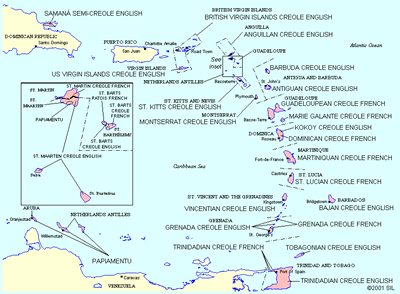
ORIGINS
It is thought that the name ‘creole’ came from Portuguese ‘crioulo’, which originally referred to the children of non-indigenous peoples (Europeans and Africans) born and raised in European colonies in the Americas, their parents’ new home away from home. The word probably came from criar (‘to raise’), and later came to be extended to the animals, culture, cuisine and speech of those born in the colonies, regardless of ethnic or national origins.
The name ‘Patois’ was originally used to refer to non-standard or non-literary regional dialects of French peasants in France. The word ‘Patois’ means ‘rough speech’ (17th century French) and is thought by some to have come from patoier (‘to treat roughly’), possibly from patte (‘paw’) in Old French, although this may be simply conjecture. The name ‘Patois’ has also been passed onto dialects of French Creole, especially in the anglophone Caribbean region.
Related to French through their mostly shared vocabulary, French Creole/Patois is a language that grew up over a relatively short period of time, and under difficult and extreme conditions. Growing up alongside French (as opposed to under or after it, as a daughter language), Patois developed its own grammar, its own sound system, and its own range of meanings. Historically dependent on French for its lexicon, French Creole remains independent at every other linguistic level, including the fundamental grammar.
Unlike French, which took over a thousand years to develop out of Latin (which is now dead, or immortal, as some would like to say), French Creole grew up in a matter of possibly two generations. Many varieties of French Creole developed simultaneously around the world, and some of these are mutually intelligible, but some are not. Trinidad’s French Creole was born out of other varieties of French Creole from the francophone and former francophone Caribbean, and is therefore closer to the French creoles of the Lesser Antilles than it is to those of Louisiana, Haiti and French Guiana.
Patois is a contact language – one born out of contact between and among speakers of vastly different languages. Under arduous conditions, speakers of 17th and 18th century Norman French and many other French dialects (both standard and regional/popular dialects) came face to face with speakers of Ewe, Igbo, Twi, Wolof, Yoruba, and some fifteen other West African languages, some of which were unrelated to one another. Picture the difficulties in communication, and the need for a common language that would serve the communication needs of all these groups. Under these circumstances was French Creole born in the ‘New’ World, a brand new language similar in some respects to all of the languages that participated in its development, but different from all – a new language in its own right.
HISTORY OF TRINIDADIAN PATOIS (FRENCH CREOLE)
Although Trinidad was never claimed by the French, Trinidad became similar to former French colonies in many ways. The island was actually under Spanish control for some 300 years, from 1498 up to the period 1797–1803 (officially British from 1797, until independence as part of Trinidad and Tobago in 1962). Tobago, on the other hand, was claimed by the French, but, unlike Trinidad, little or no trace of French or French Creole remained in Tobago, except for very few toponyms.
Trinidad's French history came about because of the proclamation of the second Cedula de Población that allowed Catholic settlers and their enslaved workers as well as free coloureds entry into Trinidad. French citizens and others (including some Irish) came in their droves, soon outnumbering the Spanish. With the French came the French and French Creole languages. Trinidad was socially and culturally “colonised” by the French from 1783. As historian Pierre-Gustave-Louis Borde put it, “Trinidad at that time seemed like a French colony which Spain had recently acquired”. By the time the British arrived, Trinidad’s population was about 28,000 people, of whom 20,000 were French Creole-speaking enslaved Africans.
While Spanish remained the language of government, of archival records and of the law courts, French was the language of commerce and society for many years. For some four decades after the arrival of the French, the French language was used for official purposes, until 1823, Governor Ralph Woodford having ruled in 1814 that English should be introduced into the law courts. Advertisements and correspondence in French continued to appear in the English-dominated newspapers of the mid to late nineteenth century.
In 1845, attorney-general Charles William Warner, very powerful in his time, declared in the Legislative Council that “English rights and privileges should only be given to those who would take the trouble to learn English and to bring up their children in an English way”. By 1851, English was introduced via primary schools, which probably marked the beginning of the end of French, Patois and other languages in Trinidad.
In the 19th century, Patois became the lingua franca of Trinidad, crossing every ethnolinguistic, social and geographic boundary, and facilitating communication among speakers of over 20 languages in the mid-19th century. Many Patois speakers also spoke some French and/or sang French songs, and many speakers of French, namely, French Creoles and others also spoke Patois and/or sang Patois songs.






















